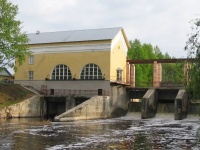- Home
- →
- Attractions
- →
- Structure HPP in Lepel
Structure HPP in Lepel
Lepel Hydroelectric Power Station is one of the small hydroelectric plants in Belarus, located on the Ulla River. Commissioned in 1958, it became an important part of the region's energy infrastructure. However, in the early 1970s, the station ceased power generation and was abandoned. After a long period of inactivity, the Lepel Hydroelectric Power Station was reconstructed and resumed operation on October 18, 2003. Today, its capacity is 320 kW, and its annual electricity generation reaches 2 million kWh, covering half of the electricity needs of the city of Lepel.
History of Construction and Modernization
Construction of the Lepel Hydroelectric Power Station began in 1958. To support its operation, the Lepel Reservoir was created, raising the water level in the Ulla River by 3.7 meters, with a maximum depth of 33.7 meters. In the early 2000s, the hydroelectric plant was given a second life: in 2001, reconstruction began, during which two 160 kW generators were replaced, the cable system was modernized, and a new automation system was installed.
Equipment and Service Life
Despite a long period of inactivity, the technical equipment of the hydroelectric power station remained in working condition. Two vertical shaft turbines of the "Francis" system, manufactured by the German company Voith in the 1950s, were inspected and found to be fit for operation. Today, the Lepel Hydroelectric Power Station continues to function, with a planned service life of at least 25 years following modernization.
Excursions to Lepel Hydroelectric Power Station
Lepel Hydroelectric Power Station is not only an important energy facility but also an interesting tourist attraction. Excursions around Belarus that include a visit to this unique small hydroelectric plant offer a chance to see its operation, learn about its history, and enjoy the picturesque views of the Lepel Reservoir.

